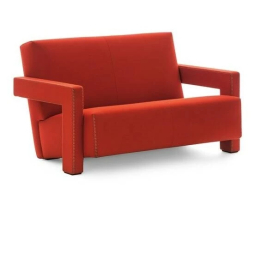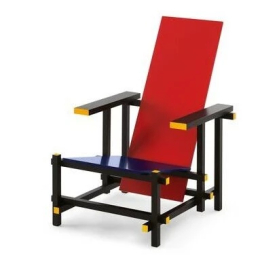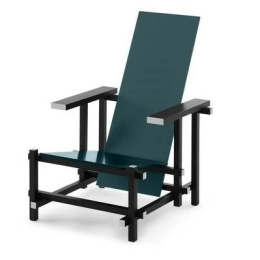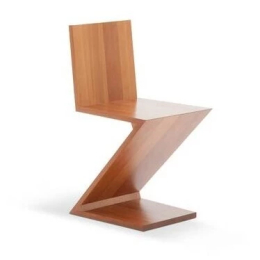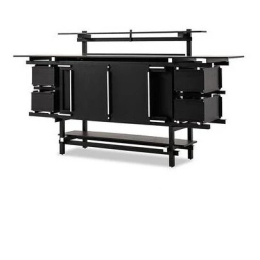Preferences
Gerrit Thomas Rietveld by Cassina
7 resultsCollection: Gerrit Thomas Rietveld
Brand: Cassina
Specifications:
Gerrit Rietveld came up with the design for the Utrecht armchair in 1935 while working for the Metz & Co. department store in Amsterdam, where his brief was to make a chair for serial production. Taking market needs into account, while privileging a comfortable and relaxing experience, led to the elements of the chair being treated as separate units. As a consequence, the chair became an icon of both the Neoplastic movement (aka De Stijl), and of Rietveld’s experimental vision. In 2015, the original version of the chair, without the feet, was made available alongside the one with, as part of the Mutazioni collection, and was relaunched with its dimensions adjusted to take account of changes in people’s height over the previous 80 years. The chair is also available in the Gerrit fabric, with blanket stich or zig-zag top-stitching, in both cases in five colours.
Collection: Gerrit Thomas Rietveld
Brand: Cassina
Specifications:
Cassina offers a new reinterpretation of the iconic model dated 1935: it is a new version, with reduced sizes to be ergonomically suited to children. Small armchair with main frame, seat and backrest in poplar plywood. Massive poplar wood armrests. Polyurethane foam and polyester padding. Not removable upholstery: fabric (in two shades of red) or eco-leather (in the colours red, yellow, blue) with white fine stitching. Feet in black plastic material.
Collection: Gerrit Thomas Rietveld
Brand: Cassina
Specifications:
A sculptural seat with a pure and rationalist form, this chair became an authentic Manifesto for Neoplasticism, embraced by the Dutch De Stijl movement in 1917. An outlook shared by Piet Mondrian, whose objective was to seek out the essential nature of things, combined with the harmonious equivalence of colours, and the use of right-angle. Rietveld produced his first prototypes in 1918, expressing the philosophy of organising space using the same colours for similar components. He later applied this same approach to separate out constructional elements according to their function. Thus the base was black, and the seats coloured. As a consequence, the name of the piece changed, from Slat Chair to Red and Blue.
Collection: Gerrit Thomas Rietveld
Brand: Cassina
Specifications:
The Black Red and Blue (Zeilmaker version) born from Rietveld’s chromatic experimentation. While researching the origins of the Red and Blue model in collaboration with the Rietveld heirs, it emerged that the key idea of the first prototypes was based on the concept of spatial organisation expressed through the monochrome tones of its elements. The first version was in fact produced in 1918 in completely unpainted wood. In the following years Rietveld proposed various examples, either monochrome or painted in different colours, depending on the requirements of his customers and the interiors for which the chairs were intended. As such, it comes as no surprise to find this 1920s version, presented as part of Cassina’s MutAzioni selection, created for the school teacher Wicher Zeilmaker with a black frame with white ends and a dark green painted seat and backrest. It was Rietveld’s ever-increasing involvement in the De Stijl movement that led him to also use primary colours on this model in 1923, and as such the chair became a veritable manifesto for the emerging neoplastic movement. Initially dubbed Slat chair, Rietveld only gave it the name Red and Blue in the 1950s following its chromatic evolution. The various owners of the different examples used the chair as an abstract- realist sculpture in their interiors and, in some cases, as a simple tool for sitting on, adding cushions to make it more comfortable, just like Cassina offers for the Black Red and Blue today.
Collection: Gerrit Thomas Rietveld
Brand: Cassina
Specifications:
Cassina offers a new reinterpretation of the iconic model dated 1935: an anthropometric response to the increasing sizes of modern generations. Armchair with main frame, seat and backrest in poplar plywood and fir solid wood. Massive poplar wood armrests. Polyurethane foam and polyester padding. Not removable upholstery: fabric or leather with blanket fine stitching in natural colour. Feet in black plastic material.
Collection: Gerrit Thomas Rietveld
Brand: Cassina
Specifications:
Designed by Gerrit Rietveld, this chair provided an early example of a cantilevered seat, and is composed of four wood boards articulated end-to-end to form an extremely eye-catching example of an unstable structure. Eschewing the traditional legs-seat-back sequence, Rietveld created a ribbon of wood forming a Z-shape. The crafts mastery of Cassina’s carpenters is seen in the execution of the dove-tail joints, which add to the beauty of the piece. The aesthetic uniqueness of this piece can be seen particularly well in the coloured version, its open-pore finish highlighting the veins of the wood on the front and sides. This finish reflects a number of variations on the theme made by Rietveld, designed to highlight the relationship between the vertical, oblique and horizontal lines.
Collection: Gerrit Thomas Rietveld
Brand: Cassina
Specifications:
Represents, with the Red and Blue, the essence of the new spatial concept of neoplasticism. A key benchmark in the establishment of the Modern style, this sideboard, designed in 1919, was originally used in the model home designed by J․P Oud for Spargen, Rotterdam, and in various interior design projects, including the project for P․J Elling. The original model was destroyed in a fire and was only rebuilt under the supervision of the designer in 1951 for an exhibition at the Stedelijk Museum in Amsterdam. Today, Cassina produces this storage unit for the first time in its historic carpentry in Meda, in collaboration with the designer’s heirs. The pure lines of the structure create a grid based on a structural core to which surfaces, drawers and storage units are added. The model is influenced by F․L․ Wright and the Anglo- Japanese art of E․W․ Godwin, particularly as regards the accentuated horizontal surfaces, which are offset by the vertical supports which form a grid from which the storage compartments are hung. The supporting grid, virtually continuous, has contrasting sections of slats that exalt their dynamism towards the exterior.
Gerrit Thomas Rietveld, Dutch architect and furniture designer ,was born in Utrecht on June 24, 1888. One of the leading members of the De Stijl art movement, famous for his Red and Blue Chair and for the Rietveld Schröder House, a UNESCO World Heritage Site. The son of a carpenter, Rietveld, he left school at eleven to apprentice his father and enrolled in night school. He works as a draftsman for C.J. Begeer, a jeweler from Utrecht, from 1906 to 1911. In 1917 he opened his own cabinet-making and furniture-making workshop. Rietveld is self-taught in learning drawing, painting and model making. Rietveld designed the famous Red and Blue Chair in 1917. Hoping to produce his furniture in series rather than handcrafted, Rietveld focuses on simplicity of components and construction. In 1918, he starts the activity of his furniture factory, adds colors to his best known chair, influenced by the De Stijl movement, of which he becomes a member in 1919, the same year he becomes an architect.
